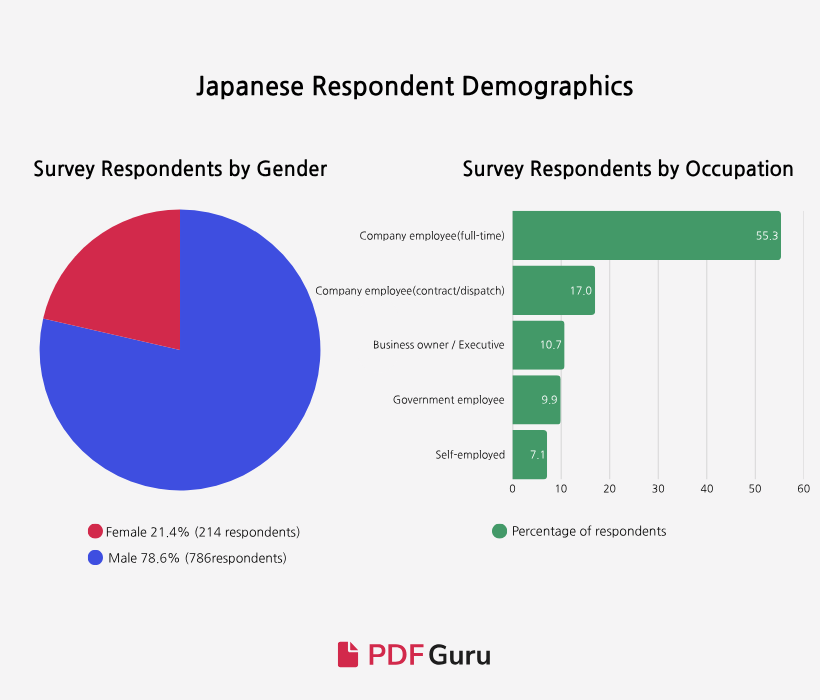Introduction
Although Korea and Japan are geographically close and share certain cultural similarities, their workplace digital transformation approaches differ markedly. In Korea, electronic approval systems, cloud-based collaboration tools, and mobile document management platforms have been widely adopted, driving many companies to digitize their workflows relatively rapidly. In contrast, Japan still relies heavily on paper documents, hanko seals, and manual approval processes, leading to a slower transition to electronic documents and automated workflows. As a result, office workers in each country experience efficiency, convenience, and change in distinctly different ways within their respective work environments. To better understand these differences, PDF Guru surveyed 1,506 employed respondents — 506 in Korea and 1,000 in Japan — comparing their document storage, creation, and sharing methods and their satisfaction with digital transformation. The survey explored which tools employees actually use, how actively they adopt digital solutions, and how they perceive changes in their work environments. In this article, we analyze the survey findings to highlight the contrasting work styles of Korean and Japanese office environments and to examine each country's challenges and opportunities on its path toward digital transformation.
Survey Methods
PDF Guru partnered with two online survey firms — Tillion Pro in Korea and Freeasy24 in Japan — to comprehensively survey office workers. Invitations were sent to 1,506 respondents (506 in Korea and 1,000 in Japan) to examine document usage and the state of digital transformation. The Korean survey was conducted from May 22 to May 23, 2025, and consisted of six questions addressing respondents’ experiences and perceptions related to document storage, creation, sharing methods, and satisfaction with digitalization. These results were compared with corresponding questions from a previous study done in Japan.
Key Findings of the Survey
Digital Document Storage Methods
Hybrid storage (both paper & digital) is nearly universal in both markets (45 % KR vs. 48 % JP)
Pure digital storage is more common in Korea (15 % vs. 9 %)
Japan still leans more heavily on paper-only storage (17 % vs. 10 %).
Paper Usage in Approval Processes
Approval workflows see similar document print rates (43 % KR vs. 40 % JP)
Japan stands out for legal/public filings: one-third of Japanese (33 %) print these documents versus 27 % of Koreans—a statistically significant gap tied to the entrenched hanko seal culture
Perceived Importance of Technology
Koreans rate technology more favorably at every level: 44 % call it important (vs. 38 % JP) and 32 % essential (vs. 24 % JP)
Japanese are twice as likely to view tech as sometimes useful (30 % vs. 20 %) or not important (8 % vs. 4 %).
Preferred Document Creation Tools
Microsoft Word dominates in Japan (62 % JP vs. 37 % KR)
Whereas 23 % of Koreans use domestic Hangul software
Koreans also outpace Japanese in cloud‐based editors (Google Docs 15 % vs. 8 %; other cloud tools 14 % vs. 9 %).
Document Sharing Methods
Koreans favor external drives (HDD/USB) for sharing (36 % vs. 19 %)
Japanese rely more on cloud storage (24 % vs. 15 %) and printed documents (23 % vs. 15 %)
Internal servers are equally popular (33 % KR vs. 35 % JP)
Satisfaction with Digitalization
Korean employees express higher satisfaction—42 % somewhat satisfied (vs. 34 % JP) and 20 % very satisfied (vs. 10 % JP)
whereas 19 % of Japanese report outright dissatisfaction (vs. 6 % KR).
Key takeaway: Across storage, creation, sharing, and satisfaction metrics, Koreans consistently demonstrate a stronger embrace of digital tools—domestic software, cloud platforms, and pure‐digital workflows—while Japanese workplaces exhibit persistent paper‐centric practices (hanko approvals, printing, traditional file servers) that slow their overall digital transformation.
Survey Results
Q1. How do you normally store internal documents?
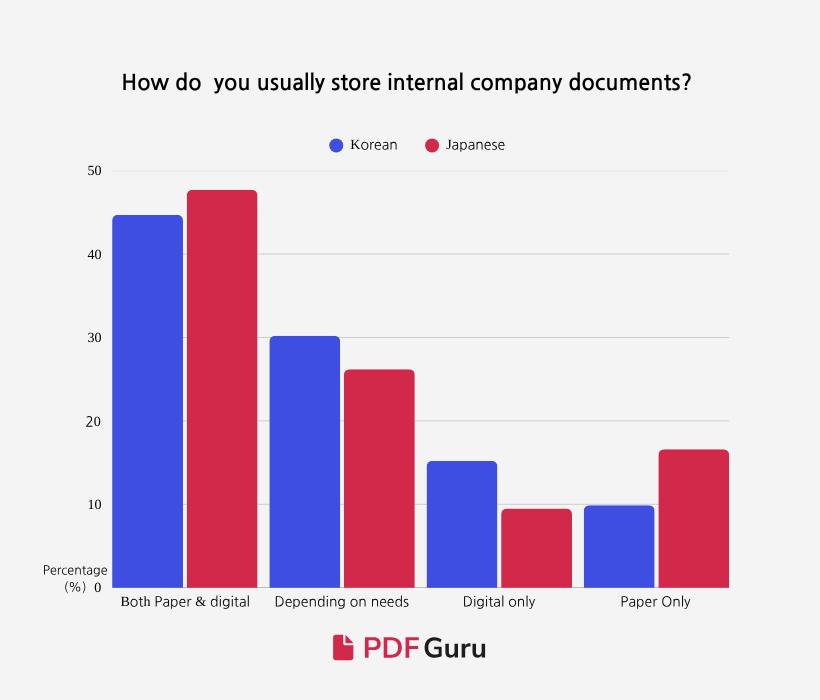
When it comes to using both paper and digital storage, South Korean respondents (45 %) and their Japanese counterparts (48 %) are almost neck and neck. “Digital only” storage, however, is noticeably more common in South Korea (15 % vs. 9 %), while “paper only” use remains stronger in Japan (17 % vs. 10 %). And even in that middle ground of “depending on needs,” Koreans lean on a flexible, case-by-case approach more often (30 % compared to Japan’s 26 %). Overall, Koreans skew more digitally inclined — both in pure digital adoption and situational mixed storage—whereas Japanese respondents show a firmer attachment to paper-only workflows.
Q2. In what situations do you use paper documents?

Printing for approval purposes is comparable between Koreans (43 %) and Japanese (40 %), with the 3-point gap not reaching statistical significance. Likewise, the share of respondents who print lengthy or complex documents (27 % vs. 25 %) does not differ significantly. In contrast, 33 % of Japanese respondents print legal or public filings — compared to 27 % of Koreans — a difference that is statistically significant. In Japan, many respondents continue to rely on paper documents due to the entrenched hanko (seal) approval system. Even as e-signatures gain traction, these long-standing cultural practices continue to slow digital adoption.
Q3. How important is technology in helping you manage your work tasks?
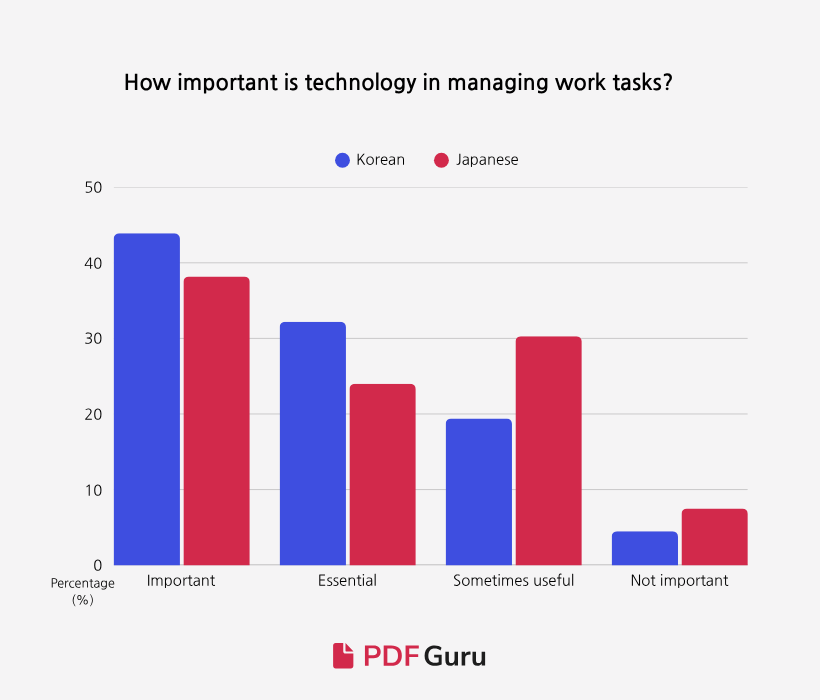
Koreans consistently rate technology as more critical to managing work tasks than their Japanese counterparts, and all observed gaps are statistically significant. For example, 44 % of Koreans versus 38 % of Japanese call technology “important,” and 32 % vs. 24 % label it “essential.” Conversely, more Japanese see tech as only “sometimes useful” (30 % vs. 20 %) or “not important” (8 % vs. 4 %). These results highlight a clear cultural divide: Koreans lean more heavily on technology for work, while the Japanese are more inclined to downplay its necessity. Moreover, this tech divide mirrors Japan’s more substantial reliance on paper-based workflows, where entrenched cultural practices can slow digital adoption compared to South Korea.
Q4. Which software or platform do you primarily use to create internal documents?

Korean and Japanese respondents exhibit markedly different preferences for internal document creation tools. In Japan, 62 % of users rely on Microsoft Word. In contrast, just 37 % of Koreans do — and notably, 23 % of Koreans employ Hangul-based software (from Hancom), a domestic alternative not mirrored in the Japanese sample. Despite the existence of Japanese word-processing solutions, none emerged as a primary choice, underscoring Japan’s dependence on Microsoft Word. Koreans also demonstrate greater adoption of cloud-based platforms: 15 % use Google Docs versus 8 % in Japan, and 14 % use other cloud services compared with 9 %. Conversely, traditional pen-and-paper remains more prevalent in Japan (18 % versus 9 %). All observed differences, except for the “Other” category (2 % vs. 3 %), are statistically significant. Together with earlier findings, these results reinforce that Koreans are more inclined to integrate digital tools into their workflows than their Japanese counterparts.
Q5. How do you create and share documents?
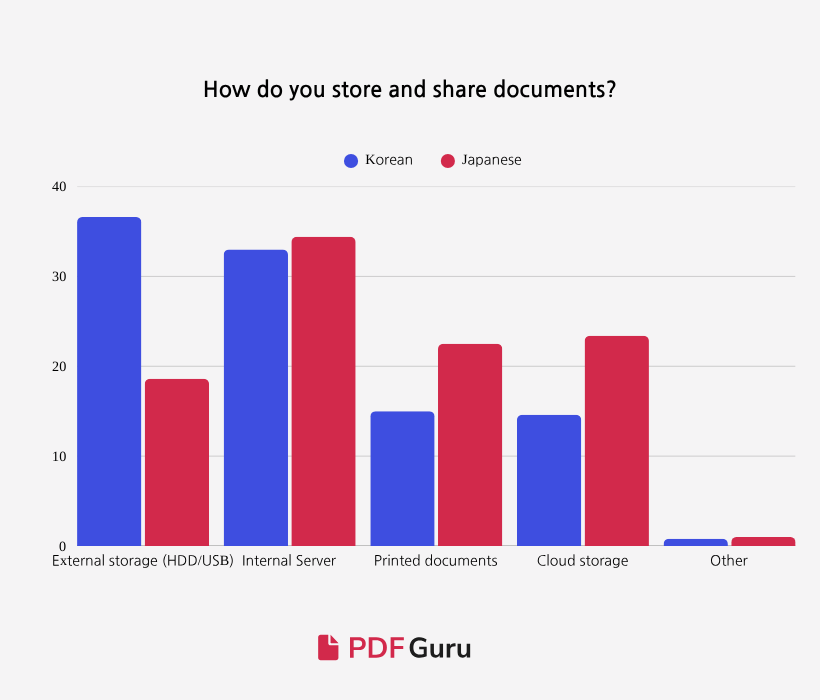
Korean and Japanese respondents diverge sharply in their preferred methods for creating and sharing documents, with several of these gaps reaching statistical significance. Koreans overwhelmingly favor external storage devices — 36 % rely on HDDs or USB drives compared with 19 % of Japanese — while cloud storage is notably more popular in Japan (24 % vs. 15 %). Printed document sharing also shows a significant tilt toward Japan, with 23 % of Japanese using it versus 15 % of Koreans. In contrast, internal servers see nearly identical usage in both countries (33 % in Korea and 35 % in Japan), and “Other” methods remain negligible (1 % vs. 2 %). These findings underscore Koreans’ continued reliance on physical, portable media, even as Japanese offices embrace a mix of traditional printing and cloud-based distribution — reinforcing the broader pattern of faster digital-tool adoption in Korea.
Q6. How satisfied are you with the overall level of digitalization in your company?
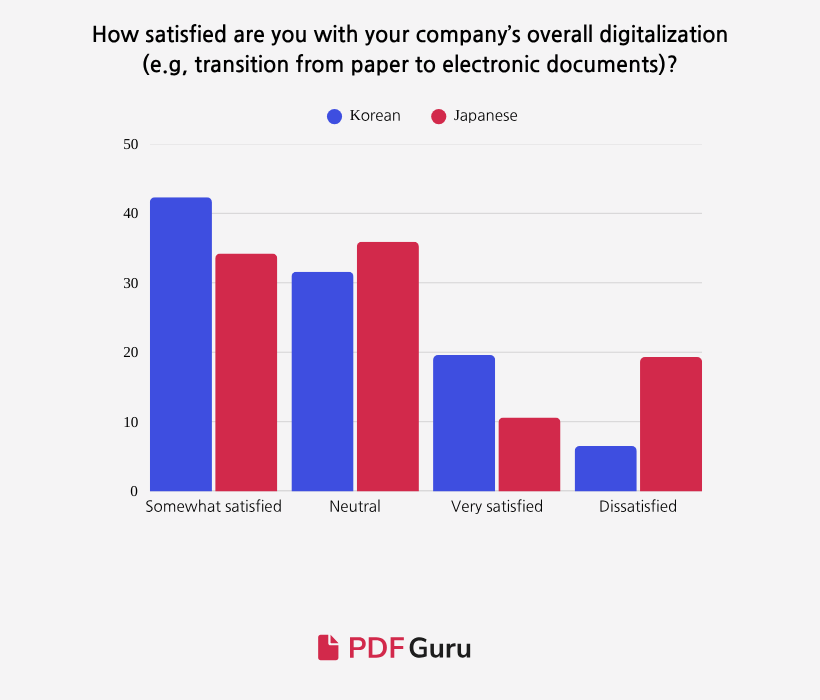
Koreans report higher satisfaction with workplace digitalization than their Japanese counterparts: 42 % of Koreans are “somewhat satisfied” versus 34 % of Japanese, and 20 % are “very satisfied” compared with just 10 % in Japan. In contrast, 19 % of Japanese say they are “dissatisfied” versus only 6 % of Koreans — a gap may stem from Japan’s slower shift away from paper-based workflows (for example, hanko seal approvals) and continued dependence on legacy on-premises systems. These figures indicate room for improvement in South Korean offices and even more so for Japan.
Conclusion
Korean office workers have embraced digital workflows far more enthusiastically than their Japanese counterparts. In Korea, employees routinely store and share documents online, use cloud-based editors and home-grown software, and rate technology as essential to their jobs. Japanese workers, by contrast, still lean heavily on paper, printed hand-offs, on-premise servers, and traditional seal approvals, and express lower satisfaction with digital tools. To help Japanese companies catch up, organizations should offer hands-on training in electronic approvals, partner with local software providers to build trust, roll out secure, user-friendly cloud platforms, and tie team incentives to paperless targets. These steps can break down cultural resistance and accelerate the shift to more efficient, fully digital operations. PDF Guru supports your work innovation with OCR automatic classification, e-signatures, collaborative editing, and secure cloud storage. For more details, check out our blog!
Korean Respondent Attributes
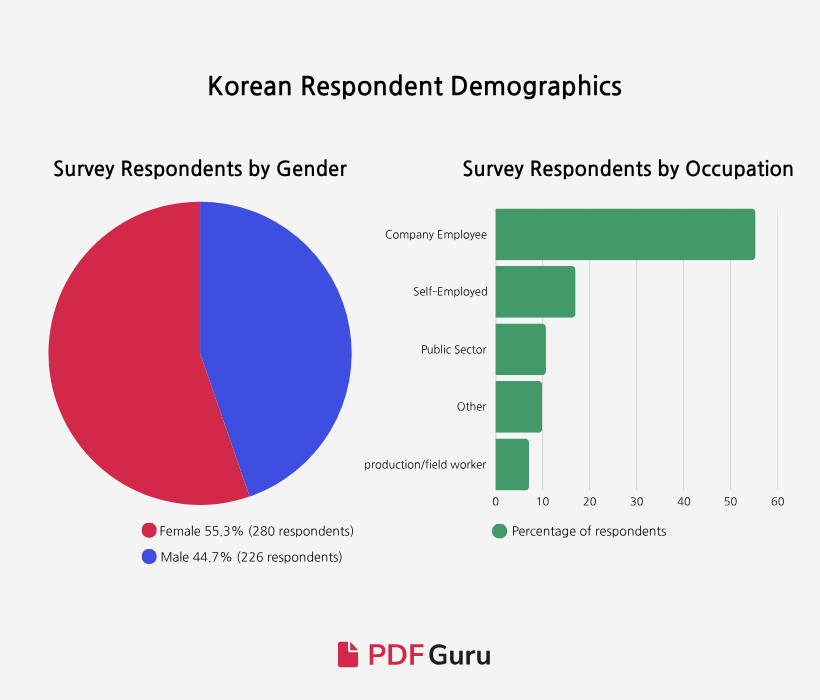
Japanese Respondent Attributes
